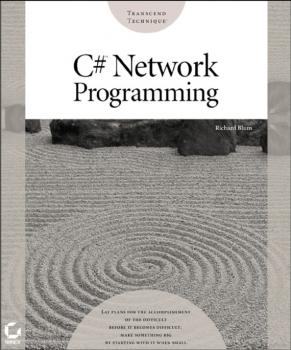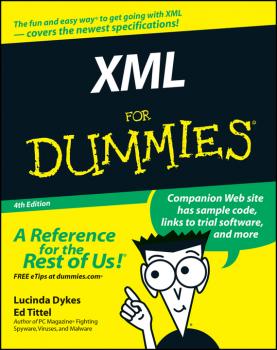John Wiley & Sons Limited
Все книги издательства John Wiley & Sons LimitedOracle9i DBA JumpStart
Get Up to Speed for Oracle9i Administration Training Courses–Fast! Oracle9i DBA JumpStart gives you the solid grounding you need to approach Oracle certification with confidence: * Introduction to relational database concepts * Using basic SQL*Plus and iSQL*Plus commands * Understanding Oracle database functions * Using multiple tables * Restricting, sorting, and grouping data * Creating and maintaining a database * Using SQL*Plus reporting techniques * Creating and maintaining database objects * Setting up users and managing security * Configuring optimization * Creating backups * Troubleshooting
C# Network Programming
On its own, C# simplifies network programming. Combine it with the precise instruction found in C# Network Programming, and you'll find that building network applications is easier and quicker than ever. This book helps newcomers get started with a look at the basics of network programming as they relate to C#, including the language's network classes, the Winsock interface, and DNS resolution. Spend as much time here as you need, then dig into the core topics of the network layer. You'll learn to make sockets connections via TCP and «connectionless» connections via UDP. You'll also discover just how much help C# gives you with some of your toughest chores, such as asynchronous socket programming, multithreading, and multicasting. Network-layer techniques are just a means to an end, of course, and so this book keeps going, providing a series of detailed application-layer programming examples that show you how to work with real protocols and real network environments to build and implement a variety of applications. Use SNMP to manage network devices, SMTP to communicate with remote mail servers, and HTTP to Web-enable your applications. And use classes native to C# to query and modify Active Directory entries. Rounding it all out is plenty of advanced coverage to push your C# network programming skills to the limit. For example, you'll learn two ways to share application methods across the network: using Web services and remoting. You'll also master the security features intrinsic to C# and .NET–features that stand to benefit all of your programming projects.
Ground-Up Java
Learn Java From the Ground-Up—With Animated Illustrations that You Manipulate This is the first effective Java book for true beginners. Sure, books before now focused on basic concepts and key techniques, and some even provided working examples on CD. Still, they lacked the power to transform someone with no programming experience into someone who sees, who really «gets it.» Working with Ground-Up Java, you will definitely get it. This is due to the clarity of Phil Heller's explanations, and the smoothly flowing organization of his instruction. He's one of the best Java trainers around. But what's really revolutionary are his more than 30 animated illustrations, which you'll find on the enclosed CD. Each of these small programs, visual and interactive in nature, vividly demonstrates how its source code works. You can modify it in different ways, distinctly altering the behavior of the program. As you experiment with these tools—and you can play with them for hours—you'll gain both the skills and the fundamental understanding needed to complete each chapter's exercises, which steadily increase in sophistication. No other beginning Java book can take you so far, so quickly, and none will be half as much fun. Note: CD-ROM/DVD and other supplementary materials are not included as part of eBook file.
Photoshop CS Savvy
Savvy – n. Practical know-how. Just about anyone who works with digital images needs to know to how to use Photoshop. But its complexity can be confounding even to experienced users. In Photoshop CS Savvy, artist and teacher Steve Romaniello reveals the secrets behind Photoshop's power—showing you how to combine theory with practical techniques to get results that are inspirational and satisfying. Whether you're a graphic artist, photographer, web designer, desktop publisher, or, if your goal is to become Photoshop savvy, this is the book that will get you there. Work your way through from cover to cover or zero in on any topic, from setting up a Photoshop workflow to restoring old photos to creating a web photo gallery. In Hands On tutorials, you'll apply your knowledge in complex, real-world projects, mastering the techniques your own work demands. A 32-page full-color section showcases numerous color-related examples. Coverage includes: Core Photoshop Skills: selections, type, layers, paths, paint effects, alpha channels, Quick Mask, scanning, transformations. Features New in Photoshop CS: Shadow/Highlight correction, photo filters, Match Color, Color Replacement, Liquify enhancements, automations, support for raw camera files. Image Retouching: Dodge and Burn tools, cloning and healing, History Brush, Dust and Scratches filter. Color Management and Correction: levels and curves, color mapping, hue and saturation, channel mixing, CMYK conversion, printing. Photoshop, ImageReady, and the Web: page layout, optimization, image maps, animations, rollovers. Advanced Techniques: difficult selections, compositing, automation, duotones and spot color, advanced layering, 16-bit editing, preparing images for digital video. Note:CD-ROM/DVD and other supplementary materials are not included as part of eBook file.
Security+ Fast Pass
Get the streamlined tool you need to bone up for the Security+ exam [SYO-101]. Fast Pass coverage includes: General security concepts. Assessing risk. Securing communications. Implementing wireless security features. Configuring a firewall. Detecting intrusions. Securing your organization's infrastructure. Understanding the basics of cryptography. Managing security keys and certificates. Ensuring operational and organizational security. Recovering from disasters. A CD-ROM so you can practice, practice, practice. Concise, objective-focused coverage and review questions. Order your copy of the perfect preparation and review resource, Security+ Fast Pass today! Note:CD-ROM/DVD and other supplementary materials are not included as part of eBook file.
TCP/IP Foundations
The world of IT is always evolving, but in every area there are stable, core concepts that anyone just setting out needed to know last year, needs to know this year, and will still need to know next year. The purpose of the Foundations series is to identify these concepts and present them in a way that gives you the strongest possible starting point, no matter what your endeavor. TCP/IP Foundations provides essential knowledge about the two protocols that form the basis for the Internet, as well as many other networks. What you learn here will benefit you in the short term, as you acquire and practice your skills, and in the long term, as you use them. Topics covered include: The origins of TCP/IP and the Internet The layers comprising the OSI and DoD models TCP/IP addressing Subnet masks Creating custom subnet masks Supernetting and Classless Inter-Domain Routing (CIDR) Name resolution The Domain Name System (DNS) and Dynamic DNS Windows Internet Naming Services (WINS) The Dynamic Host Configuration Protocol (DHCP) What to expect with IPv6
Network+ Fast Pass
Get the Perfect Preparation and Review Resource Network+ Fast Pass is the streamlined tool you need to hone in on the Network+ exam. The accompanying CD-ROM lets you practice, practice, practice, and you'll keep the book–packed with concise, objective-focused coverage and review questions–at your side until the minute you sit down to take the test. Coverage includes: Media and Topologies: Components, Cabling, Connections, Wireless. Protocols and Standards: the OSI Model, Routing and Addressing Schemes, the TCP/IP Suite, Common Ports, Access and Authentication. Network Implementation: Operating Systems, Security, Fault Tolerance, Disaster Recovery. Network Support: Utilities, Diagnostic Procedures, Remedies, Documentation. Order your copy today. Note: CD-ROM/DVD and other supplementary materials are not included as part of eBook file.
XML For Dummies
See how XML works for business needs and RSS feeds Create consistency on the Web, or tag your data for different purposes Tag – XML is it! XML tags let you share your format as well as your data, and this handy guide will show you how. You'll soon be using this markup language to create everything from Web sites to business forms, discovering schemas and DOCTYPES, wandering the Xpath, teaming up XML with Office 2003, and more. Discover how to * Make information portable * Use XML with Word 2003 * Store different types of data * Convert HTML documents to XHTML * Add CSS to XML * Understand and use DTDs
RFID For Dummies
Many companies have asked suppliers to begin using RFID (radio frequency identification) tags by 2006 RFID allows pallets and products to be scanned at a greater distance and with less effort than barcode scanning, offering superior supply-chain management efficiencies This unique plain-English resource explains RFID and shows CIOs, warehouse managers, and supply-chain managers how to implement RFID tagging in products and deploy RFID scanning at a warehouse or distribution center Covers the business case for RFID, pilot programs, timelines and strategies for site assessments and deployments, testing guidelines, privacy and regulatory issues, and more
Professional Assembly Language
Unlike high-level languages such as Java and C++, assembly language is much closer to the machine code that actually runs computers; it's used to create programs or modules that are very fast and efficient, as well as in hacking exploits and reverse engineering Covering assembly language in the Pentium microprocessor environment, this code-intensive guide shows programmers how to create stand-alone assembly language programs as well as how to incorporate assembly language libraries or routines into existing high-level applications Demonstrates how to manipulate data, incorporate advanced functions and libraries, and maximize application performance Examples use C as a high-level language, Linux as the development environment, and GNU tools for assembling, compiling, linking, and debugging









